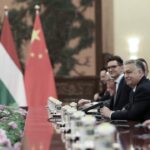Photo: Spencer Platt/Getty Images
A lone Trash can lay on its side at the intersection of W. 139th St and Amsterdam Ave in Harlem, in front of the gates of the City College of New York.
At around 11 p.m. on Tuesday night, this was the extent of damaged property that I witnessed outside the college campus. At the same time, New York Police Department officers in riot regalia had amassed in their hundreds, including members of the Strategic Response Group — a unit dedicated to public unrest and “counterterrorism.”
More police had stormed through the school’s neo-Gothic gates less than an hour before, at the behest of the college’s president, to arrest protesting students en masse.
Twenty blocks south, police had locked down and barricaded all streets in a two-block radius of Columbia University, brutally arresting students inside the inaccessible campus.
Between Columbia and City College, over 200 protesters — almost all students — were arrested before the night was out.
It was a police response reminiscent of the repression that met protesters in the 2020 George Floyd uprisings. Nearly four years ago, police also responded with extraordinary violence to a mass protest. Then, the alleged provocation involved crucial acts of militant resistance, including low-level but widespread property damage, scattered looting, and the burning of several empty police vehicles.
Tuesday was different. In recent days on the campuses in Manhattan and across the country, massive police operations came in response to peaceful student encampments. Students gathered to share food, maintaining space to hold teach-ins and rallies, and demand their universities divest from Israel.
At Columbia, student protesters took over one university building: Hamilton Hall, the same building seized by students in 1968 in protest of the Vietnam War. At most, the latest building occupation saw a few broken windowpanes and some furniture moved around.
I have never witnessed, at the scene of a protest, the use of police power so disproportionate to the type of demonstration taking place.
The negligible acts of property damage were not, of course, what was being policed. Nor was the holding of campus space; students have done this before in recent decades without their university administrators inviting the force of militarized police.
Instead, it was the protesters’ message that was being handcuffed — the condemnation of Israel and the calls for a free Palestine — and young peoples’ commitment to it.
I have been reporting on political dissent and violent policing for 15 years, particularly in New York City. Compared to Tuesday night, I have never witnessed, at the scene of a protest, the use of police power so disproportionate to the type of demonstration taking place.
Make no mistake: This is an authoritarian escalation.
The “Outside Agitator” Myth
The crackdown on campuses offered a grim continuity: Police and other officials churned out all the same old excuses for quashing resistance. Most notably, their rhetoric relied on the predictable canard of the “outside agitator.”
New York Mayor Eric Adams trotted it out as grounds for sending in an army of baton-wielding cops against the city’s students. And Deputy Police Commissioner Tarik Sheppard went even further on MSNBC Wednesday morning, brandishing an unremarkable chain lock — the sort of which I’ve seen on bikes everywhere — as proof that “professionals,” not students themselves, had carried out the takeover of the Columbia building.
The bike-lock business quickly came in for rightly deserved mockery, but the “outside agitator” myth is no joking matter.
In this current moment, the “outside agitators” conjured are both the perennial anarchist bogeymen or Islamist terror groups sending funds to keep student encampments flush with the cheapest tents available online.
The “outside agitator” trope has a long, racist legacy, including use by the Ku Klux Klan. In the 1930s, the Klan issued flyers in Alabama claiming that “paid organizers for the communists are only trying” to get Black people “in trouble.” The allegation does double rhetorical harm by denying the agency and commitment of organizers themselves and suggesting that “outside” support from beyond a given locale or institution is somehow a bad thing.
More recently, the canard has been hauled out in defense of movement repression in Atlanta, against Stop Cop City protesters who had made a national call for backup.
During the 2020 uprising, politicians nationwide often repeated the refrain of blaming outside agitators, a tactic also seen during the earlier Black Lives Matter protests in Ferguson after the death of Mike Brown by police.
The idea of outside agitators or interests being responsible for unrest has always been a propaganda ploy, and it continues to be used today. The notion that the Palestinian liberation struggle is merely a proxy for Iranian interests echoes past delegitimizing tactics.
Solidarity encampments in support of Gaza on college campuses are organized and led by students, with Palestinian and Jewish students playing significant roles. Over 1,000 students have even faced arrest for their activism.
Millions of people worldwide have called for an end to Israel’s genocidal war, emphasizing that support for Palestinian liberation should not be confined to campus activism.
The current political climate in the U.S. is marked by brutal policing, bipartisan support for crackdowns, and a combination of far-right attacks on education, white supremacist police repression, and U.S. hegemony abroad.
The charge of antisemitism is increasingly used to suppress anti-Zionist speech and justify authoritarian abuses, including genocidal wars.
The recent police crackdown on protests reflects the desperation of American institutions supporting an indefensible war in Gaza.
Israel’s actions in Gaza have shattered the redemptive myths of the post-World War II political order, leading young people, even those from Zionist families, to stand in solidarity with Palestine.
City College President Vince Boudreau invited the NYPD to intervene on campus, specifically mentioning protesters refusing to take down a Palestinian flag. The subsequent removal of the flag and raising of the American flag by the police symbolized the suppression of dissent and celebration of state power.
Source link





